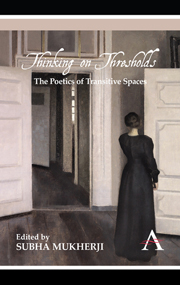Book contents
- Frontmatter
- ACKNOWLEDGEMENTS
- Contents
- List of Illustrations
- Notes on Contributors
- Introduction
- Part One Doors, Windows, Entries
- 1 Windows: Looking In, Looking Out, Breaking Through
- 2 ‘Zero…Zero…and Zero’: Permeable Walls and Off-stage Spaces
- 3 ‘The Queer Part Doors Play’ in Nabokov's Laughter in the Dark
- 4 ‘Invasion from Outer Space’: The Threshold of Annunciations
- Part Two Lives and Narratives, Territories and Worlds
- Part Three Matter, Mind, Psyche
- Part Four Reading, Writing, Playing, Listening
- Select Bibliography (including Discography)
1 - Windows: Looking In, Looking Out, Breaking Through
from Part One - Doors, Windows, Entries
Published online by Cambridge University Press: 05 March 2012
- Frontmatter
- ACKNOWLEDGEMENTS
- Contents
- List of Illustrations
- Notes on Contributors
- Introduction
- Part One Doors, Windows, Entries
- 1 Windows: Looking In, Looking Out, Breaking Through
- 2 ‘Zero…Zero…and Zero’: Permeable Walls and Off-stage Spaces
- 3 ‘The Queer Part Doors Play’ in Nabokov's Laughter in the Dark
- 4 ‘Invasion from Outer Space’: The Threshold of Annunciations
- Part Two Lives and Narratives, Territories and Worlds
- Part Three Matter, Mind, Psyche
- Part Four Reading, Writing, Playing, Listening
- Select Bibliography (including Discography)
Summary
Windows: all about us, unremarkable; or remarkable mainly in their scientific extensions, as microscopes, telescopes, X-rays, CAT scans. Here it is the unremarked I want to examine: domestic windows, and some of their meanings in literature.
What is a window? framed space? A liminal connection between inner and outer? an aperture that reveals a scene beyond, or a scene within? an impermeable membrane? security against weather and intruders? or the source of replenishing light? Doors police the threshold, windows relate the outside world to the interior. But windows, particularly in cinema, as often suggest spying and seclusion as they do an opening into the contingent world outside the self. Hitchcock's Rear Window is the classic example. The act of photography funnels sight through an aperture upon a scene at once distanced and held, beyond the power of touch. Paintings may present themselves as windows into a landscape, as we experience in Corot or in Bruegel, or the figures in them may crowd forward, bulging out of the frame towards us, as if emerging through a window. That effect is found in Pre-Raphaelite work, for example, in Rossetti's picture in the Fitzwilliam Museum of a girl peering out of a lattice window. My materials and my argument here, though, are concerned not so much with visual art as with literature and with the unframed images that writing conjures in the reader's mind.
- Type
- Chapter
- Information
- Thinking on ThresholdsThe Poetics of Transitive Spaces, pp. 3 - 16Publisher: Anthem PressPrint publication year: 2011



